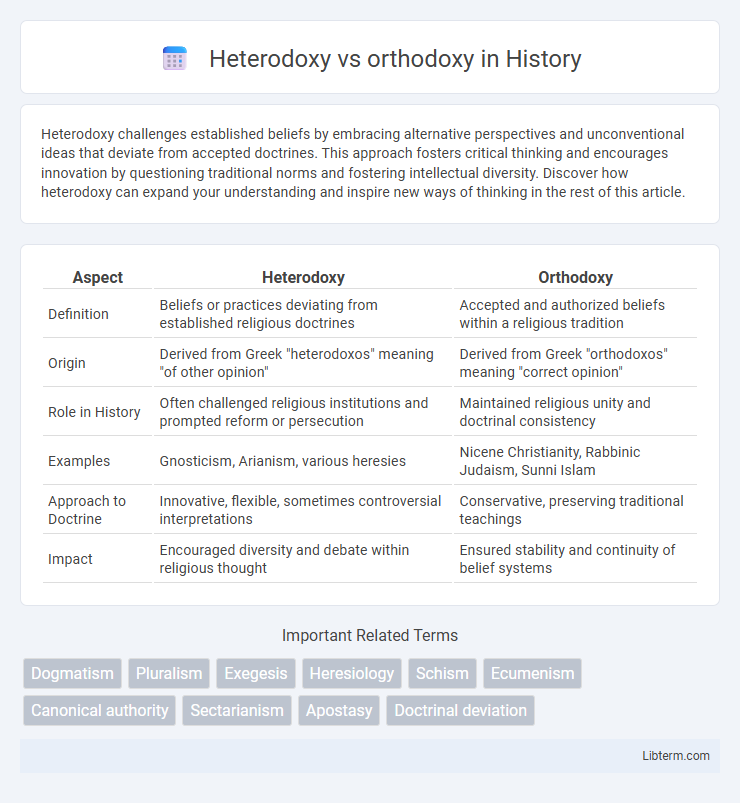Heterodoxy challenges established beliefs by embracing alternative perspectives and unconventional ideas that deviate from accepted doctrines. This approach fosters critical thinking and encourages innovation by questioning traditional norms and fostering intellectual diversity. Discover how heterodoxy can expand your understanding and inspire new ways of thinking in the rest of this article.
Table of Comparison
| Aspect | Heterodoxy | Orthodoxy |
|---|---|---|
| Definition | Beliefs or practices deviating from established religious doctrines | Accepted and authorized beliefs within a religious tradition |
| Origin | Derived from Greek "heterodoxos" meaning "of other opinion" | Derived from Greek "orthodoxos" meaning "correct opinion" |
| Role in History | Often challenged religious institutions and prompted reform or persecution | Maintained religious unity and doctrinal consistency |
| Examples | Gnosticism, Arianism, various heresies | Nicene Christianity, Rabbinic Judaism, Sunni Islam |
| Approach to Doctrine | Innovative, flexible, sometimes controversial interpretations | Conservative, preserving traditional teachings |
| Impact | Encouraged diversity and debate within religious thought | Ensured stability and continuity of belief systems |
Defining Orthodoxy: Tradition and Authority
Orthodoxy is defined by adherence to established traditions and authoritative doctrines that have been historically accepted within a particular religious or ideological framework. It emphasizes maintaining consistency with foundational beliefs and practices as sanctioned by recognized institutions or leaders. This commitment to tradition provides a stable framework that distinguishes orthodox views from heterodox or unorthodox interpretations.
Understanding Heterodoxy: Dissent and Innovation
Heterodoxy represents a spectrum of beliefs that diverge from established orthodoxy, fostering critical thinking and innovative ideas within religious, philosophical, and cultural contexts. This dissent challenges mainstream doctrines, encouraging reinterpretation and adaptation that often lead to transformative advancements. Understanding heterodoxy involves recognizing its role as a catalyst for intellectual diversity and progress against the backdrop of rigid orthodox frameworks.
Historical Roots of Orthodox and Heterodox Thought
Orthodoxy traces its historical roots to early religious traditions and established dogmas that shaped institutional authority, often emphasizing conformity to canonical texts and doctrines. Heterodoxy emerged as a response to rigid orthodoxy, incorporating alternative interpretations and marginalized beliefs that challenged mainstream theological and philosophical norms. Key historical events like the Council of Nicaea and the Reformation highlight the evolving dynamics between orthodox and heterodox thought throughout religious history.
Key Differences: Core Beliefs and Interpretations
Heterodoxy challenges established doctrines by promoting diverse interpretations that deviate from traditional orthodoxy, which strictly adheres to accepted core beliefs and authoritative teachings. Core beliefs in orthodoxy are often codified and maintained through institutional authority, while heterodox views encourage reinterpretation and innovation in understanding religious or philosophical tenets. This fundamental divergence shapes theological discourse, influencing how communities validate truth and practice faith.
Influence on Religious Practices
Heterodoxy challenges traditional religious practices by encouraging alternative interpretations and evolving rituals, often leading to diverse expressions of faith within a community. Orthodoxy maintains established doctrines and rituals, reinforcing uniformity and communal identity among adherents. The dynamic between heterodoxy and orthodoxy shapes religious practices by balancing innovation with preservation, influencing worship styles, moral codes, and theological teachings.
Heterodoxy and Orthodoxy in Philosophy
Heterodoxy in philosophy challenges established doctrines by promoting alternative viewpoints that question traditional beliefs and methodologies, fostering intellectual diversity and critical thinking. Orthodoxy maintains adherence to conventional philosophical principles and widely accepted theories, ensuring stability and continuity within the discipline. The dynamic interplay between heterodoxy and orthodoxy drives philosophical progress by balancing innovation with foundational wisdom.
Societal Impact: Conformity vs. Diversity
Heterodoxy promotes societal diversity by challenging conventional beliefs and encouraging alternative perspectives, fostering innovation and cultural pluralism. Orthodoxy emphasizes conformity, reinforcing established norms and social cohesion, which can stabilize communities but may suppress dissenting ideas. The tension between heterodoxy and orthodoxy shapes societal change, balancing the need for order with the benefits of intellectual and cultural diversity.
Case Studies: Major Heterodox Movements
Major heterodox movements such as the Protestant Reformation, which challenged the Roman Catholic orthodoxy, illustrate the dynamic tension between established religious doctrines and reformist interpretations. Theological disputes during the Arian controversy in early Christianity further emphasize how heterodoxy questioned the nature of Christ against established creeds like the Nicene Creed. In the modern era, movements like Liberation Theology in Latin America critiqued traditional orthodoxy by integrating social justice concerns with Christian teachings, reshaping religious and political landscapes.
Challenges of Maintaining Orthodoxy
Maintaining orthodoxy faces significant challenges such as evolving cultural contexts, divergent interpretations, and the rise of heterodox beliefs that question established doctrines. Institutional rigidity can hinder adaptability, leading to internal contradictions and fragmentation within orthodox communities. The tension between preserving traditional dogma and responding to contemporary ethical and intellectual developments often results in doctrinal disputes and schisms.
The Future: Balancing Tradition and Change
Heterodoxy challenges established orthodoxy by introducing innovative perspectives that encourage societal and intellectual evolution. Balancing tradition and change requires integrating orthodox principles with heterodox ideas to foster adaptive progress without losing cultural or ideological identity. Future developments depend on this dynamic interplay, ensuring resilience and relevance in rapidly shifting environments.
Heterodoxy Infographic

 libterm.com
libterm.com